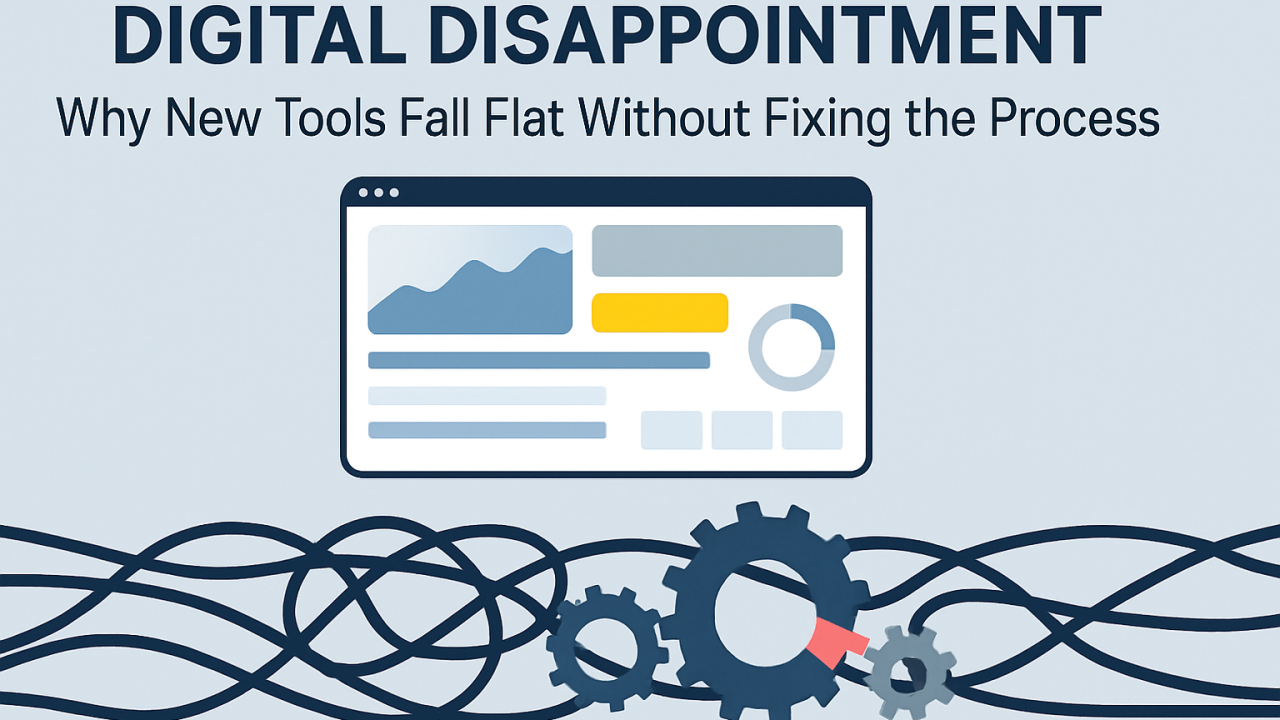Digital Disappointment: Why New Tools Fall Flat Without Fixing the Process

A familiar scenario: a company invests heavily in a powerful new platform—maybe a CRM, help desk system, or workflow automation tool. The rollout looks good on paper, the vendor demos well, and the leadership team is optimistic.
But six months in, usage is low. Workarounds are back. The support team is still copying data between systems, and operations leaders can’t get clean reports. The project quietly fizzles—another failed digital initiative.
This outcome is far more common than most leaders would like to admit.
In fact, industry research continues to reinforce what many on the ground already suspect: most digital transformation efforts do not succeed. McKinsey has estimated that 70% of digital transformations fail to achieve their intended outcomes.
It’s Rarely About the Tools
It’s easy to blame the tech when things fall apart. “The tool was too complex,” “integration was harder than expected,” or “our team just didn’t use it” are common post-mortems.
But the underlying issue is often simpler and more structural: the organization wasn’t ready to transform.
Digital transformation is rarely a technology problem. It’s a people, process, and leadership problem.
Here’s what typically goes wrong:
- Processes aren’t clearly defined. Automating a messy, inconsistent workflow just makes bad outcomes happen faster.
- Teams aren’t aligned or informed. Support and operations teams often aren’t consulted during tool selection, even though they bear the brunt of the change.
- Leadership disengages too early. Once the purchase is made, executives shift focus, assuming the tool will “just work.”
Tech Amplifies What’s Already There
Digital tools don’t create clarity or accountability. They magnify the organization’s strengths and weaknesses.
Software doesn’t solve misalignment—it exposes it.
If teams are already communicating poorly, a new platform won’t fix it. If workflows aren’t documented, automation will either stall or reinforce inefficiencies. And if leadership doesn’t actively model the behavior they expect, adoption will lag.
This is especially true for operational and customer-facing teams. Without clarity in processes, training, and goals, new systems often add friction instead of removing it.
Why Small Businesses and Support Leaders Should Pay Attention
Smaller companies and resource-constrained departments are particularly vulnerable to digital missteps. Many implement enterprise-level tools without the structure or headcount needed to make them successful.
Some common red flags:
- Purchasing software without mapping current workflows.
- Treating implementation as an IT project rather than a cross-functional initiative.
- Rolling out new tools without clear ownership or training plans.
For support and operations leaders, this can mean more manual work, less visibility, and lower morale—despite the promise of “transformation.”
The Software Fix: Diagnose Before You Deploy
Before committing to any new digital initiative, slow down and ask the hard questions:
1. What’s the current process—and is it working?
Don’t assume the new tool will fix broken workflows. Document how things actually get done today. Identify where the real friction is.
2. Who will use it, and what do they need?
Talk to the people closest to the problem. Support and ops teams know where tools fall short and what workarounds they’ve built. Their insights are critical.
3. Is leadership ready to lead the change?
Digital transformation requires sustained attention. If executive teams are not willing to model behavior, allocate resources, and reinforce priorities, change won’t stick.
Fix This: Three Actions to Take Now
Here are three simple steps to improve your odds before the next rollout:
✅ Map one key workflow end-to-end. Use a whiteboard, spreadsheet, or digital tool to visualize how a process flows today. Include every handoff and exception. You’ll find gaps fast.
✅ Create a pre-launch alignment checklist. Before signing a contract, confirm roles, goals, and use cases with all relevant stakeholders. This can prevent months of rework.
✅ Commit to post-launch leadership engagement. Digital change is a continuous process. Plan for regular check-ins, feedback loops, and visible support from leaders—not just one kickoff meeting.
The bottom line: digital transformation doesn’t fail because of bad software. It fails because we treat software as the solution, not the enabler.
Want transformation to work? Start with people, fix the process, and lead the change. The tools will follow.

